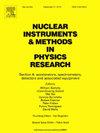一种用于水基中微子望远镜实时光学标定的摄像系统
IF 1.5
3区 物理与天体物理
Q3 INSTRUMENTS & INSTRUMENTATION
Nuclear Instruments & Methods in Physics Research Section A-accelerators Spectrometers Detectors and Associated Equipment
Pub Date : 2025-04-17
DOI:10.1016/j.nima.2025.170489
引用次数: 0
摘要
校准中微子望远镜探测介质内的光学特性对于确定其角度分辨率和能量尺度至关重要。对于计划在深水中建造的下一代中微子望远镜,如 TRopIcal 深海中微子望远镜(TRIDENT),由于水介质的动态性质和潜在的不均匀性,会面临更多的挑战。这就需要一个分布在大型探测器阵列中的实时光学校准系统。本研究介绍了一种配备快速图像处理算法的定制 CMOS 相机系统,为 TRIDENT 和全球其他类似项目提供实时光学校准方法。2021 年 9 月,TRIDENT 探路者实验(TRIDENT Explorer,简称 T-REX)在西太平洋 3420 米深处成功部署了这一摄像系统。在 30 分钟内,T-REX 光源捕获了约 3000 幅图像,从而可以对三种波长下的海水衰减和吸收长度进行原位测量。这次深海实验首次展示了在动态中微子望远镜场址运行照相机校准系统的技术演示,为未来的 TRIDENT 项目巩固了校准战略的重要组成部分。本文章由计算机程序翻译,如有差异,请以英文原文为准。
A camera system for real-time optical calibration of water-based neutrino telescopes
Calibrating the optical properties within the detection medium of a neutrino telescope is crucial for determining its angular resolution and energy scale. For the next generation of neutrino telescopes planned to be constructed in deep water, such as the TRopIcal DEep-sea Neutrino Telescope (TRIDENT), there are additional challenges due to the dynamic nature and potential non-uniformity of the water medium. This necessitates a real-time optical calibration system distributed throughout the large detector array. This study introduces a custom-designed CMOS camera system equipped with rapid image processing algorithms, providing a real-time optical calibration method for TRIDENT and other similar projects worldwide. In September 2021, the TRIDENT Pathfinder experiment (TRIDENT Explorer, T-REX for short) successfully deployed this camera system in the West Pacific Ocean at a depth of 3420 meters. Within 30 min, about 3000 images of the T-REX light source were captured, allowing for the in-situ measurement of seawater attenuation and absorption lengths under three wavelengths. This deep-sea experiment for the first time showcased a technical demonstration of a functioning camera calibration system in a dynamic neutrino telescope site, solidifying a substantial part of the calibration strategies for the future TRIDENT project.
求助全文
通过发布文献求助,成功后即可免费获取论文全文。
去求助
来源期刊
CiteScore
3.20
自引率
21.40%
发文量
787
审稿时长
1 months
期刊介绍:
Section A of Nuclear Instruments and Methods in Physics Research publishes papers on design, manufacturing and performance of scientific instruments with an emphasis on large scale facilities. This includes the development of particle accelerators, ion sources, beam transport systems and target arrangements as well as the use of secondary phenomena such as synchrotron radiation and free electron lasers. It also includes all types of instrumentation for the detection and spectrometry of radiations from high energy processes and nuclear decays, as well as instrumentation for experiments at nuclear reactors. Specialized electronics for nuclear and other types of spectrometry as well as computerization of measurements and control systems in this area also find their place in the A section.
Theoretical as well as experimental papers are accepted.

 求助内容:
求助内容: 应助结果提醒方式:
应助结果提醒方式:


